2014 MERCEDES-BENZ GL tire pressure
[x] Cancel search: tire pressurePage 21 of 462
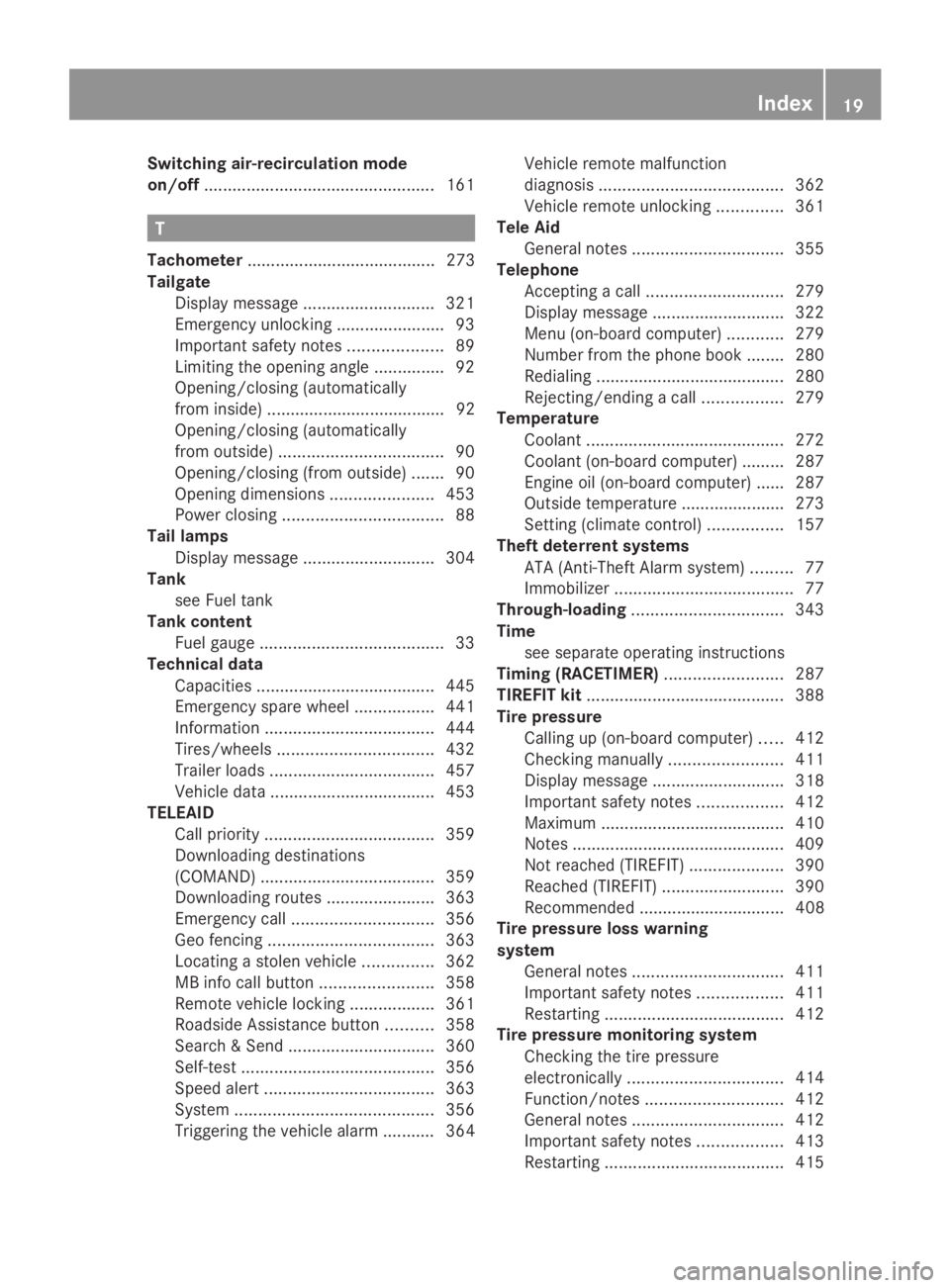
Switching air-recirculation mode
on/off.................................................161
T
Tachometer........................................ 273
Tailgate
Display message............................321
Emergency unlocking.......................93
Important safety notes....................89
Limiting the opening angle...............92
Opening/closing (automatically
from inside) ...................................... 92
Opening/closing (automatically
from outside)...................................90
Opening/closing (from outside).......90
Opening dimensions......................453
Power closing..................................88
Tail lamps
Display message............................304
Tank
see Fuel tank
Tank content
Fuel gauge.......................................33
Technical data
Capacities......................................445
Emergency spare wheel.................441
Information....................................444
Tires/wheels.................................432
Trailer loads...................................457
Vehicle data...................................453
TELEAID
Call priority....................................359
Downloading destinations
(COMAND).....................................359
Downloading routes.......................363
Emergency call..............................356
Geo fencing...................................363
Locating a stolen vehicle...............362
MB info call button........................358
Remote vehicle locking..................361
Roadside Assistance button..........358
Search & Send...............................360
Self-test.........................................356
Speed alert....................................363
System..........................................356
Triggering the vehicle alarm ........... 364
Vehicle remote malfunction
diagnosis.......................................362
Vehicle remote unlocking..............361
Tele Aid
General notes................................355
Telephone
Accepting a call.............................279
Display message............................322
Menu (on-board computer)............279
Number from the phone book ........280
Redialing........................................280
Rejecting/ending a call.................279
Temperature
Coolant..........................................272
Coolant (on-board computer) ......... 287
Engine oil (on-board computer) ...... 287
Outside temperature ......................273
Setting (climate control)................157
Theft deterrent systems
ATA (Anti-Theft Alarm system).........77
Immobilizer......................................77
Through-loading................................343
Time
see separate operating instructions
Timing (RACETIMER).........................287
TIREFIT kit..........................................388
Tire pressure
Calling up (on-board computer).....412
Checking manually........................411
Display message............................318
Important safety notes..................412
Maximum.......................................410
Notes.............................................409
Not reached (TIREFIT)....................390
Reached (TIREFIT)..........................390
Recommended ............................... 408
Tire pressure loss warning
system
General notes................................411
Important safety notes..................411
Restarting......................................412
Tire pressure monitoring system
Checking the tire pressure
electronically.................................414
Function/notes.............................412
General notes................................412
Important safety notes..................413
Restarting......................................415
Index19
Page 22 of 462
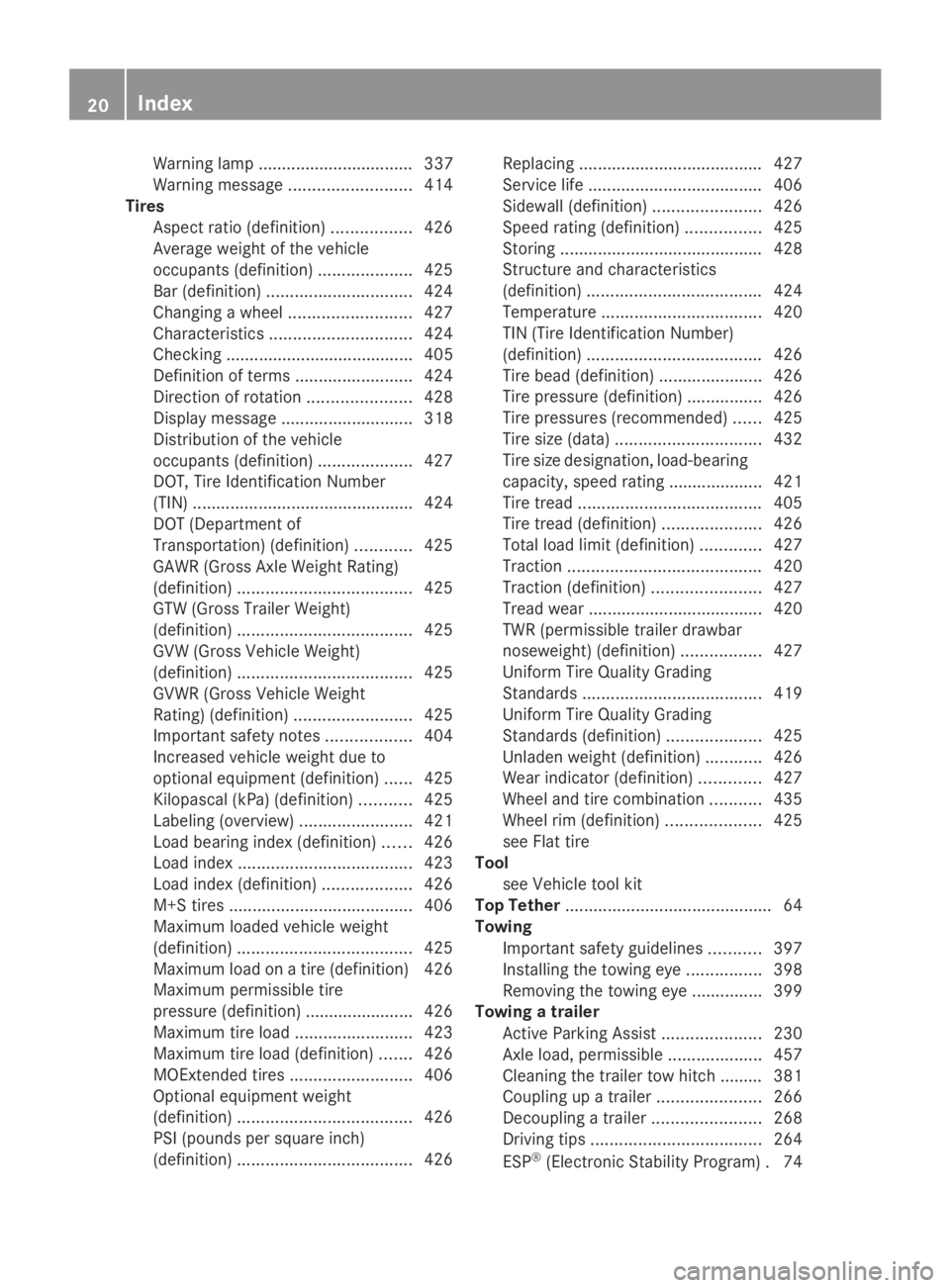
Warning lamp ................................. 337
Warning message..........................414
Tires
Aspect ratio (definition).................426
Average weight of the vehicle
occupants (definition)....................425
Bar (definition)...............................424
Changing a wheel..........................427
Characteristics..............................424
Checking ........................................ 405
Definition of terms.........................424
Direction of rotation......................428
Display message............................318
Distribution of the vehicle
occupants (definition)....................427
DOT, Tire Identification Number
(TIN) ...............................................424
DOT (Department of
Transportation) (definition)............425
GAWR (Gross Axle Weight Rating)
(definition).....................................425
GTW (Gross Trailer Weight)
(definition).....................................425
GVW (Gross Vehicle Weight)
(definition).....................................425
GVWR (Gross Vehicle Weight
Rating) (definition).........................425
Important safety notes..................404
Increased vehicle weight due to
optional equipment (definition)......425
Kilopascal (kPa) (definition)...........425
Labeling (overview)........................421
Load bearing index (definition)......426
Load index.....................................423
Load index (definition)...................426
M+S tires.......................................406
Maximum loaded vehicle weight
(definition).....................................425
Maximum load on a tire (definition) 426
Maximum permissible tire
pressure (definition) ....................... 426
Maximum tire load.........................423
Maximum tire load (definition).......426
MOExtended tires..........................406
Optional equipment weight
(definition).....................................426
PSI (pounds per square inch)
(definition).....................................426
Replacing.......................................427
Service life.....................................406
Sidewall (definition).......................426
Speed rating (definition)................425
Storing...........................................428
Structure and characteristics
(definition).....................................424
Temperature..................................420
TIN (Tire Identification Number)
(definition).....................................426
Tire bead (definition)......................426
Tire pressure (definition)................426
Tire pressures (recommended)......425
Tire size (data)...............................432
Tire size designation, load-bearing
capacity, speed rating .................... 421
Tire tread.......................................405
Tire tread (definition).....................426
Total load limit (definition).............427
Traction.........................................420
Traction (definition).......................427
Tread wear.....................................420
TWR (permissible trailer drawbar
noseweight) (definition).................427
Uniform Tire Quality Grading
Standards......................................419
Uniform Tire Quality Grading
Standards (definition)....................425
Unladen weight (definition)............426
Wear indicator (definition).............427
Wheel and tire combination...........435
Wheel rim (definition)....................425
see Flat tire
Tool
see Vehicle tool kit
Top Tether............................................64
Towing
Important safety guidelines...........397
Installing the towing eye................398
Removing the towing eye...............399
Towing a trailer
Active Parking Assist.....................230
Axle load, permissible....................457
Cleaning the trailer tow hitch ......... 381
Coupling up a trailer......................266
Decoupling a trailer.......................268
Driving tips....................................264
ESP®(Electronic Stability Program).74
20Index
Page 24 of 462
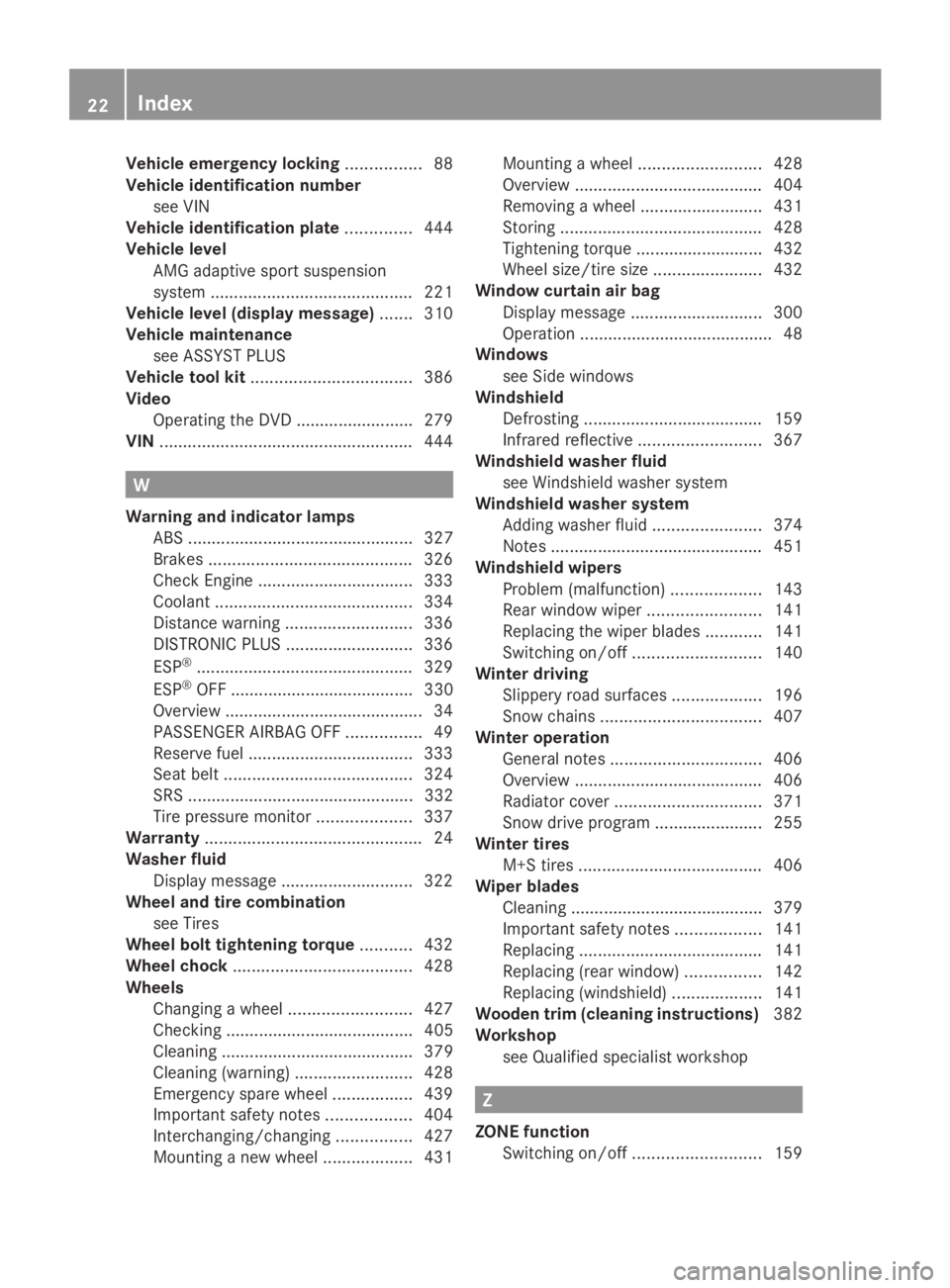
Vehicle emergency locking................88
Vehicle identification number
see VIN
Vehicle identification plate..............444
Vehicle level
AMG adaptive sport suspension
system...........................................221
Vehicle level (display message).......310
Vehicle maintenance
see ASSYST PLUS
Vehicle tool kit..................................386
Video
Operating the DVD ......................... 279
VIN......................................................444
W
Warning and indicator lamps
ABS ................................................ 327
Brakes...........................................326
Check Engine.................................333
Coolant..........................................334
Distance warning...........................336
DISTRONIC PLUS...........................336
ESP®..............................................329
ESP®OFF ....................................... 330
Overview..........................................34
PASSENGER AIRBAG OFF................49
Reserve fuel...................................333
Seat belt........................................324
SRS ................................................ 332
Tire pressure monitor....................337
Warranty..............................................24
Washer fluid
Display message............................322
Wheel and tire combination
see Tires
Wheel bolt tightening torque...........432
Wheel chock......................................428
Wheels
Changing a wheel..........................427
Checking ........................................ 405
Cleaning ......................................... 379
Cleaning (warning).........................428
Emergency spare wheel.................439
Important safety notes..................404
Interchanging/changing................427
Mounting a new wheel...................431
Mounting a wheel..........................428
Overview........................................404
Removing a wheel..........................431
Storing...........................................428
Tightening torque ........................... 432
Wheel size/tire size.......................432
Window curtain air bag
Display message............................300
Operation .........................................48
Windows
see Side windows
Windshield
Defrosting......................................159
Infrared reflective..........................367
Windshield washer fluid
see Windshield washer system
Windshield washer system
Adding washer fluid.......................374
Notes.............................................451
Windshield wipers
Problem (malfunction)...................143
Rear window wiper........................141
Replacing the wiper blades............141
Switching on/off...........................140
Winter driving
Slippery road surfaces...................196
Snow chains..................................407
Winter operation
General notes................................406
Overview........................................406
Radiator cover...............................371
Snow drive program ....................... 255
Winter tires
M+S tires.......................................406
Wiper blades
Cleaning ......................................... 379
Important safety notes..................141
Replacing.......................................141
Replacing (rear window)................142
Replacing (windshield)...................141
Wooden trim (cleaning instructions)382
Workshop
see Qualified specialist workshop
Z
ZONE function
Switching on/off...........................159
22Index
Page 25 of 462
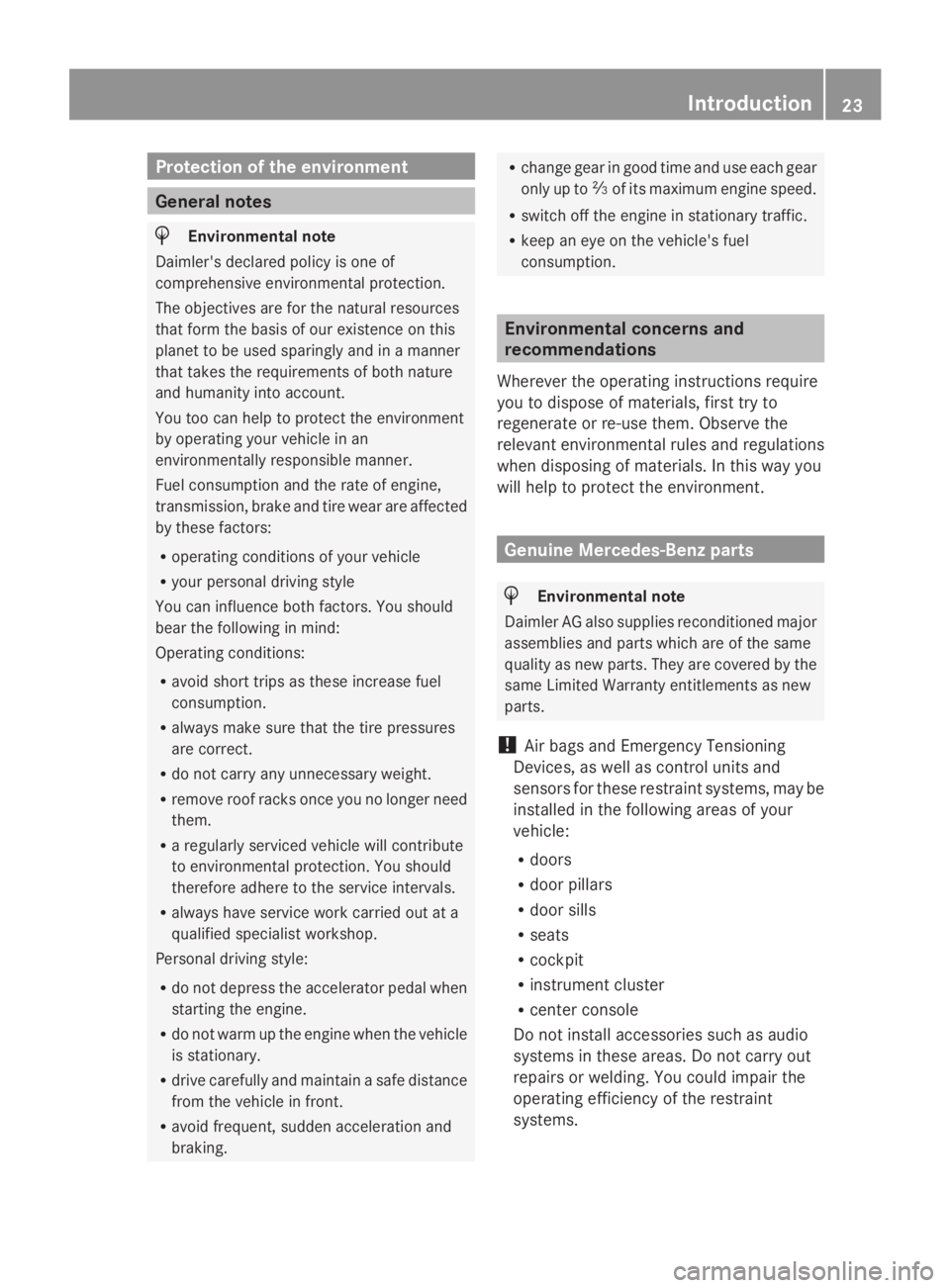
Protection of the environment
General notes
HEnvironmental note
Daimler's declared policy is one of
comprehensive environmental protection.
The objectives are for the natural resources
that form the basis of our existence on this
planet to be used sparingly and in a manner
that takes the requirements of both nature
and humanity into account.
You too can help to protect the environment
by operating your vehicle in an
environmentally responsible manner.
Fuel consumption and the rate of engine,
transmission, brake and tire wear are affected
by these factors:
Roperating conditions of your vehicle
Ryour personal driving style
You can influence both factors. You should
bear the following in mind:
Operating conditions:
Ravoid short trips as these increase fuel
consumption.
Ralways make sure that the tire pressures
are correct.
Rdo not carry any unnecessary weight.
Rremove roof racks once you no longer need
them.
Ra regularly serviced vehicle will contribute
to environmental protection. You should
therefore adhere to the service intervals.
Ralways have service work carried out at a
qualified specialist workshop.
Personal driving style:
Rdo not depress the accelerator pedal when
starting the engine.
Rdo not warm up the engine when the vehicle
is stationary.
Rdrive carefully and maintain a safe distance
from the vehicle in front.
Ravoid frequent, sudden acceleration and
braking.
Rchange gear in good time and use each gear
only up to�
Page 69 of 462
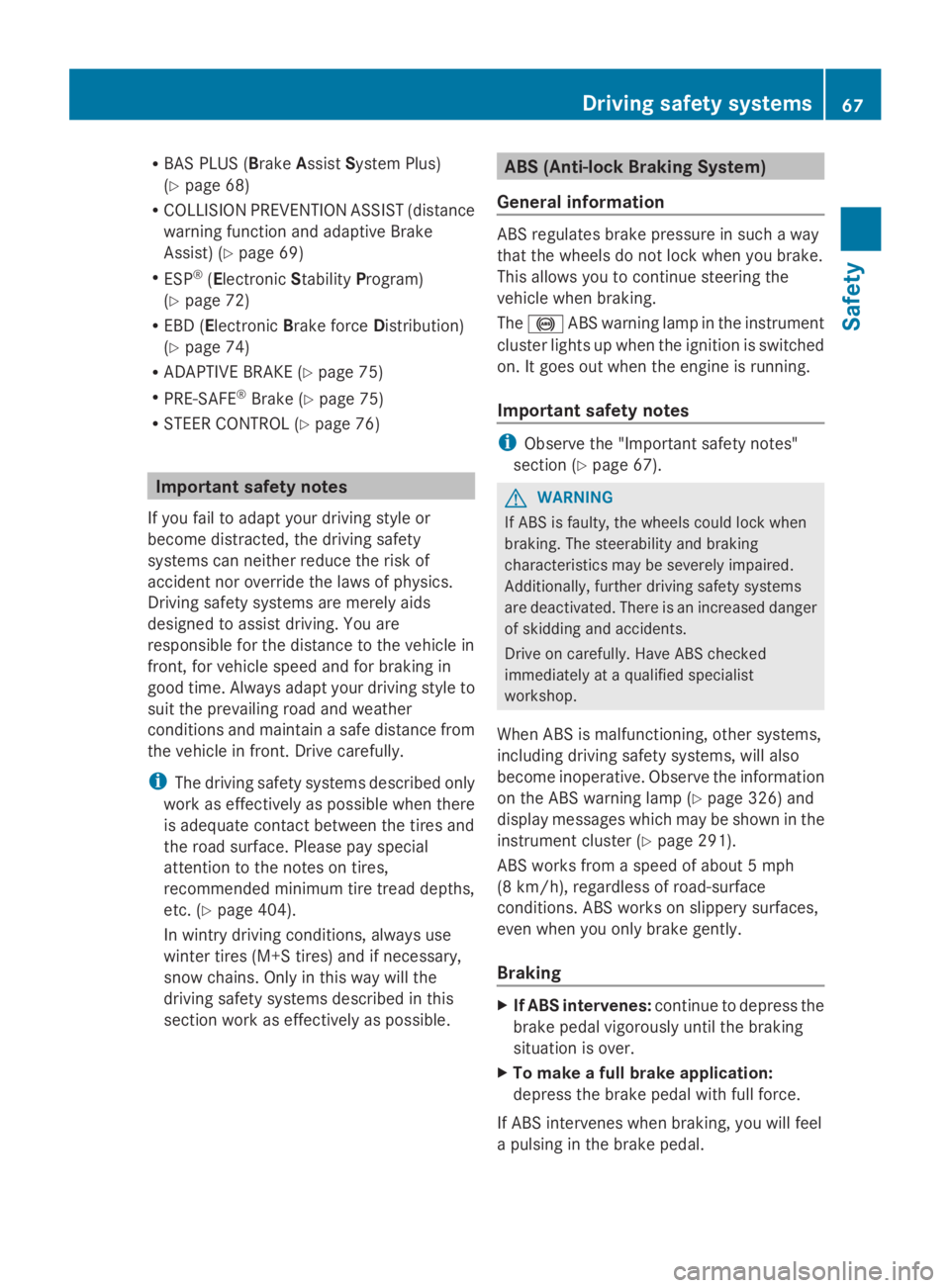
RBAS PLUS (BrakeAssistSystem Plus)
(Ypage 68)
RCOLLISION PREVENTION ASSIST (distance
warning function and adaptive Brake
Assist) (Ypage 69)
RESP®(ElectronicStabilityProgram)
(Ypage 72)
REBD (ElectronicBrake forceDistribution)
(Ypage 74)
RADAPTIVE BRAKE (Ypage 75)
RPRE-SAFE®Brake (Ypage 75)
RSTEER CONTROL (Ypage 76)
Important safety notes
If you fail to adapt your driving style or
become distracted, the driving safety
systems can neither reduce the risk of
accident nor override the laws of physics.
Driving safety systems are merely aids
designed to assist driving. You are
responsible for the distance to the vehicle in
front, for vehicle speed and for braking in
good time. Always adapt your driving style to
suit the prevailing road and weather
conditions and maintain a safe distance from
the vehicle in front. Drive carefully.
iThe driving safety systems described only
work as effectively as possible when there
is adequate contact between the tires and
the road surface. Please pay special
attention to the notes on tires,
recommended minimum tire tread depths,
etc. (Ypage 404).
In wintry driving conditions, always use
winter tires (M+S tires) and if necessary,
snow chains. Only in this way will the
driving safety systems described in this
section work as effectively as possible.
ABS (Anti-lock Braking System)
General information
ABS regulates brake pressure in such a way
that the wheels do not lock when you brake.
This allows you to continue steering the
vehicle when braking.
The�%ABS warning lamp in the instrument
cluster lights up when the ignition is switched
on. It goes out when the engine is running.
Important safety notes
iObserve the "Important safety notes"
section (Ypage 67).
GWARNING
If ABS is faulty, the wheels could lock when
braking. The steerability and braking
characteristics may be severely impaired.
Additionally, further driving safety systems
are deactivated. There is an increased danger
of skidding and accidents.
Drive on carefully. Have ABS checked
immediately at a qualified specialist
workshop.
When ABS is malfunctioning, other systems,
including driving safety systems, will also
become inoperative. Observe the information
on the ABS warning lamp (Ypage 326) and
display messages which may be shown in the
instrument cluster (Ypage 291).
ABS works from a speed of about 5 mph
(8 km/h), regardless of road-surface
conditions. ABS works on slippery surfaces,
even when you only brake gently.
Braking
XIf ABS intervenes:continue to depress the
brake pedal vigorously until the braking
situation is over.
XTo make a full brake application:
depress the brake pedal with full force.
If ABS intervenes when braking, you will feel
a pulsing in the brake pedal.
Driving safety systems67
Safety
Z
Page 194 of 462
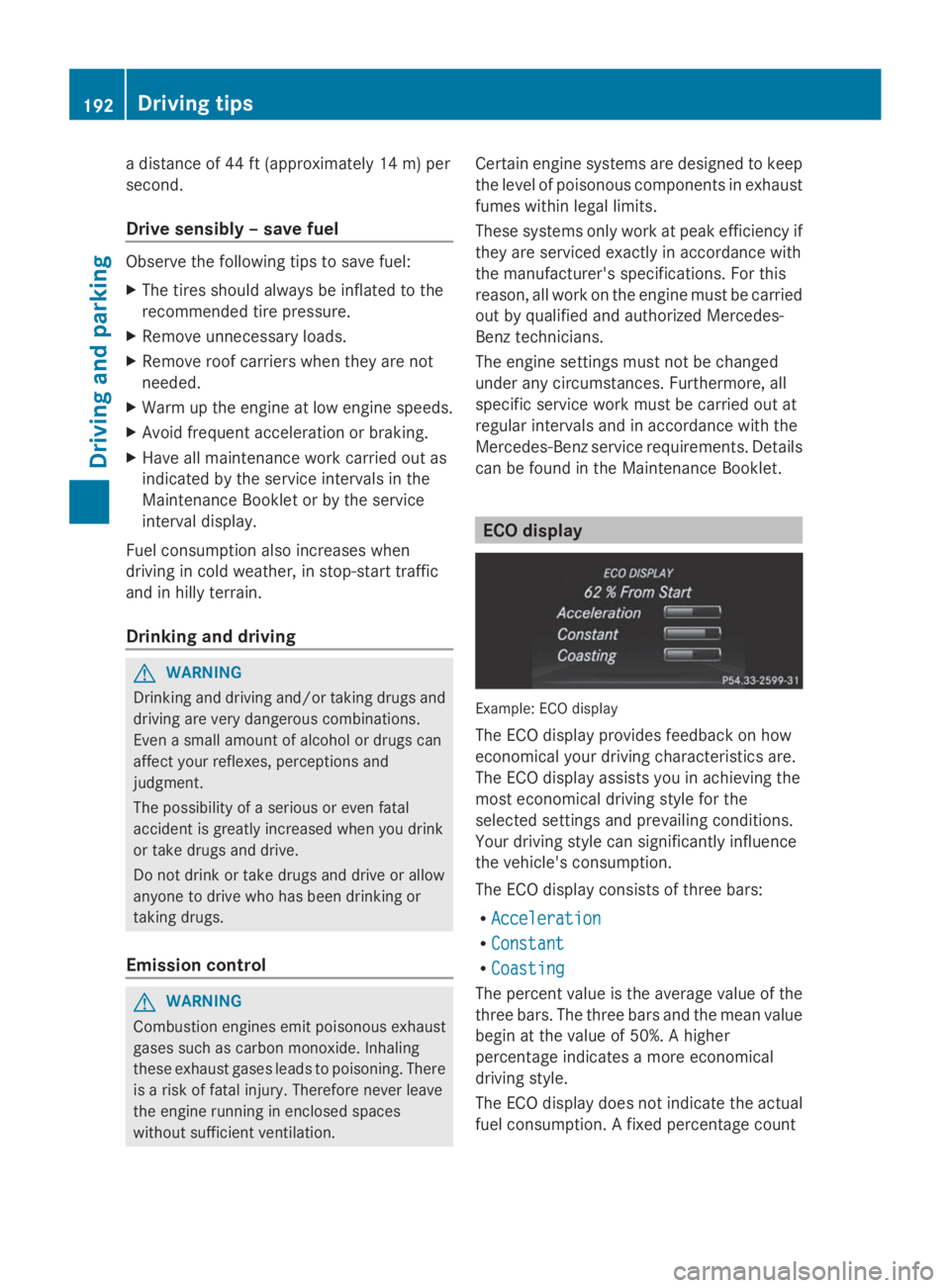
a distance of 44 ft (approximately 14 m) per
second.
Drive sensibly – save fuel
Observe the following tips to save fuel:
XThe tires should always be inflated to the
recommended tire pressure.
XRemove unnecessary loads.
XRemove roof carriers when they are not
needed.
XWarm up the engine at low engine speeds.
XAvoid frequent acceleration or braking.
XHave all maintenance work carried out as
indicated by the service intervals in the
Maintenance Booklet or by the service
interval display.
Fuel consumption also increases when
driving in cold weather, in stop-start traffic
and in hilly terrain.
Drinking and driving
GWARNING
Drinking and driving and/or taking drugs and
driving are very dangerous combinations.
Even a small amount of alcohol or drugs can
affect your reflexes, perceptions and
judgment.
The possibility of a serious or even fatal
accident is greatly increased when you drink
or take drugs and drive.
Do not drink or take drugs and drive or allow
anyone to drive who has been drinking or
taking drugs.
Emission control
GWARNING
Combustion engines emit poisonous exhaust
gases such as carbon monoxide. Inhaling
these exhaust gases leads to poisoning. There
is a risk of fatal injury. Therefore never leave
the engine running in enclosed spaces
without sufficient ventilation.
Certain engine systems are designed to keep
the level of poisonous components in exhaust
fumes within legal limits.
These systems only work at peak efficiency if
they are serviced exactly in accordance with
the manufacturer's specifications. For this
reason, all work on the engine must be carried
out by qualified and authorized Mercedes-
Benz technicians.
The engine settings must not be changed
under any circumstances. Furthermore, all
specific service work must be carried out at
regular intervals and in accordance with the
Mercedes-Benz service requirements. Details
can be found in the Maintenance Booklet.
ECO display
Example: ECO display
The ECO display provides feedback on how
economical your driving characteristics are.
The ECO display assists you in achieving the
most economical driving style for the
selected settings and prevailing conditions.
Your driving style can significantly influence
the vehicle's consumption.
The ECO display consists of three bars:
RAccelerationAcceleration
RConstantConstant
RCoastingCoasting
The percent value is the average value of the
three bars. The three bars and the mean value
begin at the value of 50%. A higher
percentage indicates a more economical
driving style.
The ECO display does not indicate the actual
fuel consumption. A fixed percentage count
192Driving tips
Driving and parking
Page 195 of 462
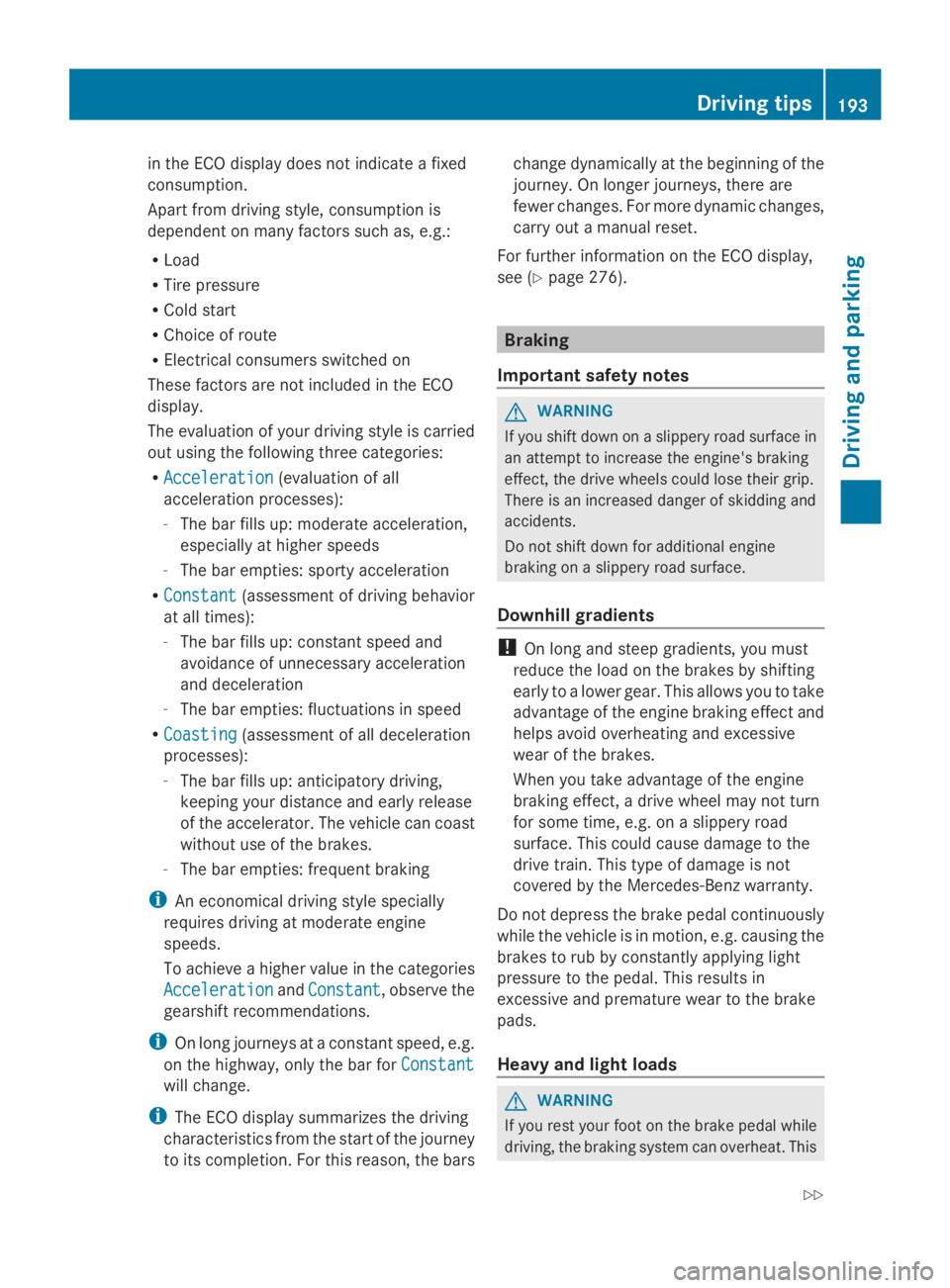
in the ECO display does not indicate a fixed
consumption.
Apart from driving style, consumption is
dependent on many factors such as, e.g.:
RLoad
RTire pressure
RCold start
RChoice of route
RElectrical consumers switched on
These factors are not included in the ECO
display.
The evaluation of your driving style is carried
out using the following three categories:
RAccelerationAcceleration(evaluation of all
acceleration processes):
-The bar fills up: moderate acceleration,
especially at higher speeds
-The bar empties: sporty acceleration
RConstantConstant(assessment of driving behavior
at all times):
-The bar fills up: constant speed and
avoidance of unnecessary acceleration
and deceleration
-The bar empties: fluctuations in speed
RCoastingCoasting(assessment of all deceleration
processes):
-The bar fills up: anticipatory driving,
keeping your distance and early release
of the accelerator. The vehicle can coast
without use of the brakes.
-The bar empties: frequent braking
iAn economical driving style specially
requires driving at moderate engine
speeds.
To achieve a higher value in the categories
AccelerationAccelerationandConstantConstant, observe the
gearshift recommendations.
iOn long journeys at a constant speed, e.g.
on the highway, only the bar forConstantConstant
will change.
iThe ECO display summarizes the driving
characteristics from the start of the journey
to its completion. For this reason, the bars
change dynamically at the beginning of the
journey. On longer journeys, there are
fewer changes. For more dynamic changes,
carry out a manual reset.
For further information on the ECO display,
see (Ypage 276).
Braking
Important safety notes
GWARNING
If you shift down on a slippery road surface in
an attempt to increase the engine's braking
effect, the drive wheels could lose their grip.
There is an increased danger of skidding and
accidents.
Do not shift down for additional engine
braking on a slippery road surface.
Downhill gradients
!On long and steep gradients, you must
reduce the load on the brakes by shifting
early to a lower gear. This allows you to take
advantage of the engine braking effect and
helps avoid overheating and excessive
wear of the brakes.
When you take advantage of the engine
braking effect, a drive wheel may not turn
for some time, e.g. on a slippery road
surface. This could cause damage to the
drive train. This type of damage is not
covered by the Mercedes-Benz warranty.
Do not depress the brake pedal continuously
while the vehicle is in motion, e.g. causing the
brakes to rub by constantly applying light
pressure to the pedal. This results in
excessive and premature wear to the brake
pads.
Heavy and light loads
GWARNING
If you rest your foot on the brake pedal while
driving, the braking system can overheat. This
Driving tips193
Driving and parking
Z
Page 200 of 462
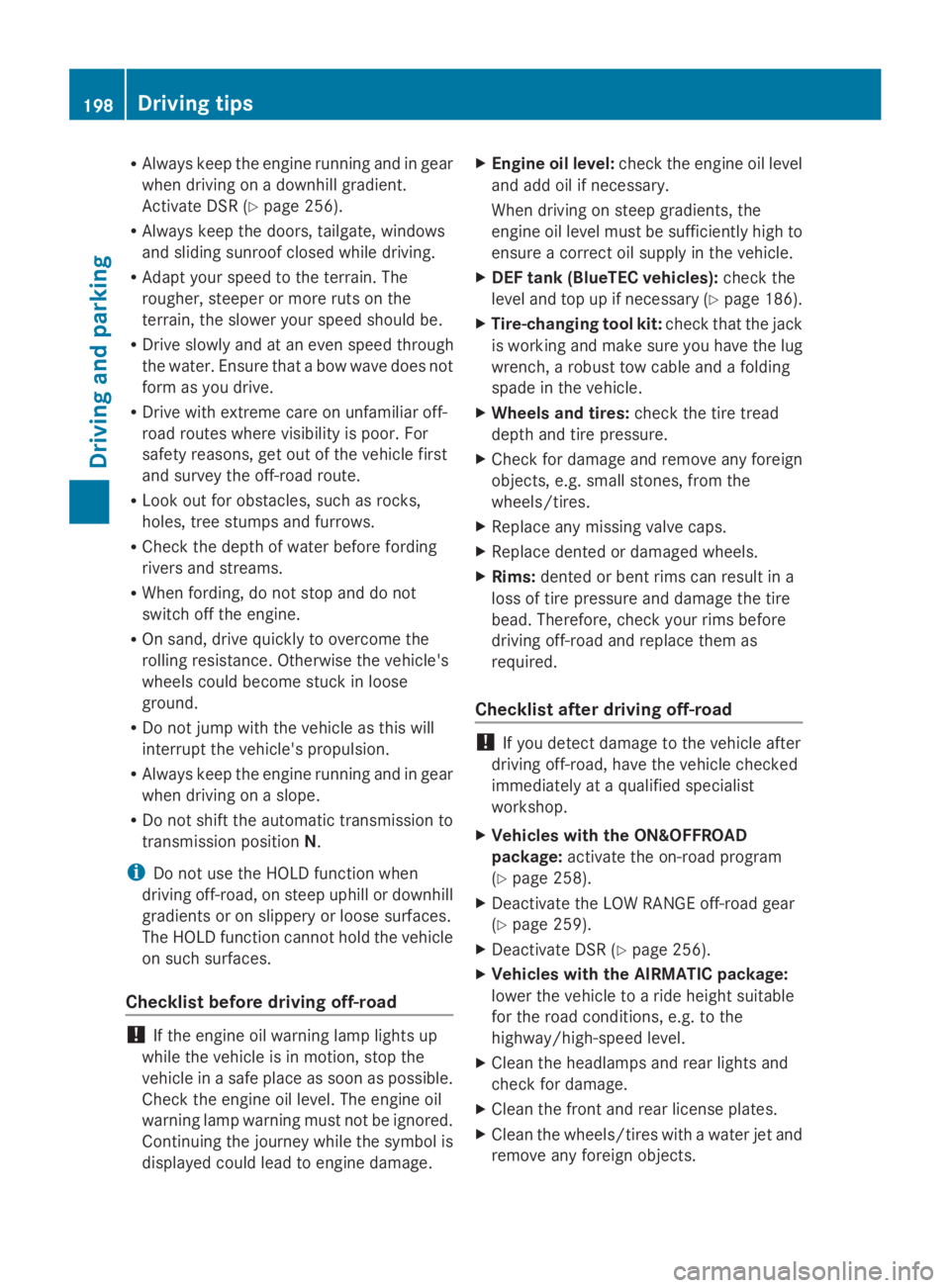
RAlways keep the engine running and in gear
when driving on a downhill gradient.
Activate DSR (Ypage 256).
RAlways keep the doors, tailgate, windows
and sliding sunroof closed while driving.
RAdapt your speed to the terrain. The
rougher, steeper or more ruts on the
terrain, the slower your speed should be.
RDrive slowly and at an even speed through
the water. Ensure that a bow wave does not
form as you drive.
RDrive with extreme care on unfamiliar off-
road routes where visibility is poor. For
safety reasons, get out of the vehicle first
and survey the off-road route.
RLook out for obstacles, such as rocks,
holes, tree stumps and furrows.
RCheck the depth of water before fording
rivers and streams.
RWhen fording, do not stop and do not
switch off the engine.
ROn sand, drive quickly to overcome the
rolling resistance. Otherwise the vehicle's
wheels could become stuck in loose
ground.
RDo not jump with the vehicle as this will
interrupt the vehicle's propulsion.
RAlways keep the engine running and in gear
when driving on a slope.
RDo not shift the automatic transmission to
transmission positionN.
iDo not use the HOLD function when
driving off-road, on steep uphill or downhill
gradients or on slippery or loose surfaces.
The HOLD function cannot hold the vehicle
on such surfaces.
Checklist before driving off-road
!If the engine oil warning lamp lights up
while the vehicle is in motion, stop the
vehicle in a safe place as soon as possible.
Check the engine oil level. The engine oil
warning lamp warning must not be ignored.
Continuing the journey while the symbol is
displayed could lead to engine damage.
XEngine oil level:check the engine oil level
and add oil if necessary.
When driving on steep gradients, the
engine oil level must be sufficiently high to
ensure a correct oil supply in the vehicle.
XDEF tank (BlueTEC vehicles):check the
level and top up if necessary (Ypage 186).
XTire-changing tool kit:check that the jack
is working and make sure you have the lug
wrench, a robust tow cable and a folding
spade in the vehicle.
XWheels and tires:check the tire tread
depth and tire pressure.
XCheck for damage and remove any foreign
objects, e.g. small stones, from the
wheels/tires.
XReplace any missing valve caps.
XReplace dented or damaged wheels.
XRims:dented or bent rims can result in a
loss of tire pressure and damage the tire
bead. Therefore, check your rims before
driving off-road and replace them as
required.
Checklist after driving off-road
!If you detect damage to the vehicle after
driving off-road, have the vehicle checked
immediately at a qualified specialist
workshop.
XVehicles with the ON&OFFROAD
package:activate the on-road program
(Ypage 258).
XDeactivate the LOW RANGE off-road gear
(Ypage 259).
XDeactivate DSR (Ypage 256).
XVehicles with the AIRMATIC package:
lower the vehicle to a ride height suitable
for the road conditions, e.g. to the
highway/high-speed level.
XClean the headlamps and rear lights and
check for damage.
XClean the front and rear license plates.
XClean the wheels/tires with a water jet and
remove any foreign objects.
198Driving tips
Driving an d parking